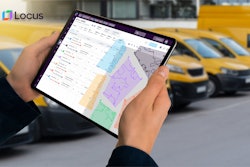
At 3:51 p.m., Solar Transport’s transportation management system showed a load had been completed. By just before 3:53 p.m., all the processes had been completed to allow for invoicing.
Register today for "Finding and Keeping Drivers in a Demand-Driven Job Market" webinar
Executives from three fleets share the driver recruiting and retention strategies that have propelled their companies to become some of the industry’s best, and how they plan to stay there. This CCJ webinar is sponsored by Bestpass.
Solar Transport uses EBE Technologies’ robotic process automation (RPA) solution that shares and compares information from disparate back-office systems – TMS, ELD, mobile comm, HRS, accounting and ATS systems – to eliminate redundant manual data entry labor and streamline business processes to create more efficiencies and profitability.
Solar was able to use RPA to eliminate 150 indexing hours per week; with its system that alerts drivers to missing paperwork, it also eliminated 30 hours a week in back-office labor, and its paperwork outstanding went from 17 to two hours, Rocco Marrari, EBE Technologies vice president of sales for imaging and workflow solutions, said during a recent Truckload Carriers Association webinar. He said using the RPA system also improved driver satisfaction and reduced turnover by around 30% because the automated process increased drivers’ home time by about 25 minutes per night (hourly drivers that do 10 to 15 moves a day).
The ever-expanding driver shortage is no secret, but with the current labor market, carriers are also experiencing challenges in recruiting and retaining back-office staff. Automated labor through RPA systems can increase back-office productivity and reduce turnover by reallocating repetitive tasks, allowing staff to focus on their areas of expertise.
“I talk to carriers daily, and everybody always asks me, ‘how can we automate more; how can we become more efficient?’ RPA processes is the start,” Marrari said. “A lot of carriers in today's environment really have a passive workflow … where yes, they're paperless; yes, it's digital, but there's still manual or time tasks associated with it. RPA takes over that process and allows that carrier to truly work on automation.”
Physical robotics devices have been used for decades to lower costs and meet quality standards, and with improvements in technology it has become virtualized, creating RPA – a business process automation that provides an 24/7, 365 e-workforce.
And there are many benefits.
For Bonnie Ramsay’s company, Halvor Lines, it starts at the driver level. Ramsay told EBE that the company was able to motivate drivers to turn in their paperwork more quickly, thus speeding up invoicing by 48 hours.
“Our personnel was spending two to four hours per person per day calling drivers begging them for necessary paperwork,” said Ramsay, CIO at Halvor.
“Now that those calls are eliminated, their back-office productivity has improved dramatically. They've also reduced revenue accruals by 94%,” Marrari said. “Again, this is something that I hear daily throughout the industry, and you'll hear this again from other carriers who experienced the same type of results when utilizing RPA processes instead of having somebody actually pick up the phone or send an email to drivers.”
Many carriers use a driver application to allow drivers to capture documents to get those back into the office as quickly as possible. RPA, with optical character recognition, can determine if any documents are missing – without involving back-office staff – and alert drivers automatically to any outstanding paperwork.
Not only does that alleviate back-office staff, it can help improve driver retention by meeting payroll expectations. The system can also automatically relay information from shippers to drivers that a dispatcher would typically have to do, saving time.
RPA can help, too, on the carrier side with one of the main benefits involving invoicing.
Many shippers are moving away from using an electronic data interface to having carriers manually update information directly on their websites, which has created additional labor for carriers so they can get paid. Marrari said some carriers have two full-time employees dedicated to uploading information, especially proof of delivery and invoicing documents.
“We had a challenge with one of our very large customers that wanted us to update their website with all the delivery information, and the pickup information, and bill of lading numbers and all sorts of information or data that we needed to enter into their websites in order for their website to generate payment to us, the freight carrier.
In moving from an EDI world to this website world, we actually took a step backward since they were no longer wanting to do EDI, which was a fairly automated process,” said Ned Kriegshauser of Hogan Services Inc.
“We now had to have several people spend their time every day monitoring these loads in our TMS system and then entering the data into the customers website,” he said. “The problem with that is twofold; of course we needed more people to actually get the job done. In addition to that, it opened a lot of room for error. If we didn't enter the proper information into their website, then payment would not be generated. In turn, we wouldn’t necessarily know that payment wasn't generated until whatever invoice we were trying to collect on reached 30 days past due.”
Any errors could affect a carrier’s EDI scorecard, causing them to lose business.
RPA fills out websites more quickly and accurately and lets them know more quickly if there is a failure, then alerting the right people to that error.
Kriegshauser said using RPA has created a more efficient process. Instead of having to update these websites over a period of two weeks or more, depending on how far behind staff was, RPA updates those websites in real time, and they get paid faster. He said it also helped cut down on training time and effort for a position with high turnover.
“It has had a huge impact on our organization,” he said.
RPA will also monitor back-office systems for accounting errors to ensure carriers are getting the proper payment amount without a staff member having to run down the money. It also helps carriers stay on top of their invoices and ensure no duplicated payments are made as the system will notice an email invoice, read it as a human would, and immediately extract all the required information to make that payment.
Marrari said RPA can be used by carriers of all sizes, even taking care of tasks as simple as distributing emails to the correct person so others don’t waste time.
He said every carrier is different, so during the discovery and requirements processes, EBE looks at best practices and determines where a carrier can most benefit from RPA based on what kind of scale the carrier wants to see in the future.
“If you’re a carrier that has any data intensive processes – maybe some that are repetitive in nature, time consuming, maybe have a high error rate – and if you want the ability to have processes run outside of the standard business hours, then you need to look at RPA processes to really help your business grow,” Marrari said.













